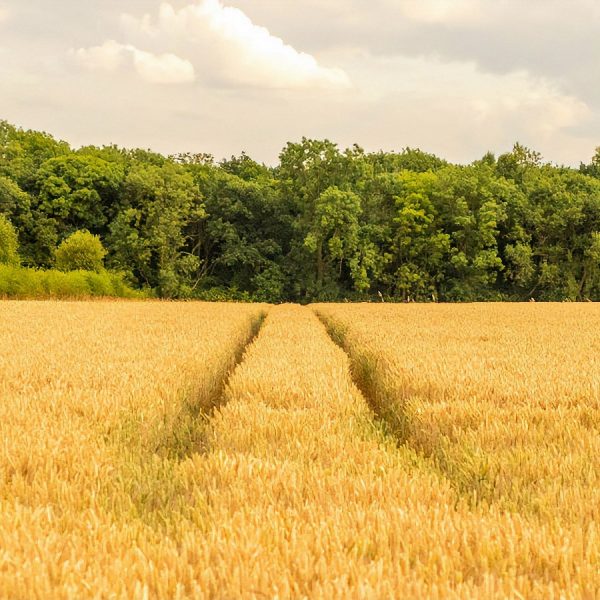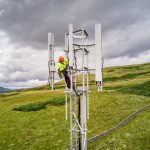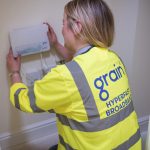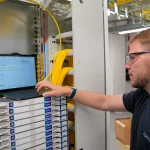Lords Told UK Farmers Have to Visit McDonald’s for Broadband

Yesterday’s debate on the forthcoming Agriculture Bill 2019-21 saw the House of Lords being told, by non-affiliated life peer Lord Holmes of Richmond, that some of the farmers he knows have such poor access to internet connectivity that they “have to go to McDonald’s to get broadband coverage.“
The new bill isn’t actually supposed to cover broadband, although a number of Lords did support an attempt by Lord Clement-Jones (Liberal Democrat) and Lord Holmes of Richmond to introduce “Amendment 157,” which would have required broadband provision and digital literacy to be added as part of the section that deals with financial support for rural development.
Rural broadband connectivity, via both fixed line ISPs and mobile (4G, 5G etc.) services, has improved a lot over the past decade but there are still some areas where even getting a slow ADSL line can be a struggle. Similarly, Ofcom’s own 10Mbps broadband Universal Service Obligation (USO) recognised that tens of thousands of homes and businesses may simply be too expensive to serve.
Advertisement
Naturally farmers, which often manage large swathes of deeply rural countryside, tend to be among those who are often the last on the list to benefit from improvements to digital connectivity. The situation is rarely ideal, particularly given the Government’s “Digital by Default” strategy, which requires farmers to do a lot more via an online-only mould than before.
Lord Holmes of Richmond said:
“I am grateful to the NFU for its support of this amendment, and I draw noble Lords’ attention to the rural connectivity survey that the NFU has conducted since 2015. What this shows is quite alarming: over that time period, on almost any measure, there has been a minimal increase in connectivity. Perhaps more worryingly, in the latest figures from 2019, there has been a 2% increase in those who say they have no broadband connectivity whatever. Farmers have told me that they have to go to McDonald’s to get broadband coverage, and while its advertising proudly states that all of its produce comes from British and Irish farmers—which is a thoroughly good thing that gives some circularity to this position—this should be a choice rather than a must for farmers.
Similarly, when one considers tax being digital by default, when farmers have approached HMRC with the issue of not being able to get online, it has been suggested to them that they go to their local library to transact their tax calculations and submissions. While all noble Lords would agree that libraries are quiet and calm places, are they really the venue where one should be forced to set out one’s finances?”
Otherwise the debate touched on a number of all too familiar areas, such as the delays and costs caused to rural 4G and 5G mobile deployments by the Government’s decision to rip-out high-risk vendors like Huawei (roll-out delays of c.2 years are already expected). The questionable 2025 deployment target for the £5bn commitment to make “gigabit capable” broadband available to every UK home also cropped-up.
In response Lord Gardiner of Kimble (Conservative) listed some of the things that the Government were doing to tackle rural broadband connectivity, such as the £5bn project mentioned above and the £200m Rural Gigabit Connectivity (RGC) programme that is handing out broadband connectivity vouchers to remote homes and businesses. The 5G focused Rural Connected Communities (RCC) programme also got a mention.
However, the Lord added that broadband and mobile connectivity was “beyond the scope of the Bill” and more a matter for DCMS than DEFRA.
Advertisement
Lord Gardiner of Kimble said:
“Returning to digital, although the current rural development programme allows for support for broadband and digital skills, wider government initiatives are the main funding mechanisms for broadband connectivity and digital skills. These are delivered through DCMS, rather than Defra.
The role played by me, as Minister for Rural Affairs, and the rural team at Defra, is to work closely with DCMS and, at ministerial level, make sure that there is a complete understanding of the fact that rural communities need to play their part in a modern economy, and of the need to improve that.”
In the end Amendment 157 was not adopted. Meanwhile the most remote and poorly connected farmers could perhaps consider a Satellite broadband service as a temporary fix, although admittedly such platforms tend not to be ideal due to high latency times, meagre data allowances and variable service speeds (especially at peak times when congestion can be a problem).
In the future some of those issues may be fixed by the new generation of LEO Satellites from companies like SpaceX (Starlink), OneWeb, Amazon and so forth. At present most of those have yet to launch any commercial broadband packages for consumers and thus we don’t yet know for sure how well they’ll hold up in a real-world deployment.
One small addition to the McDonald’s and Libraries point(s) made earlier. Most of these were inaccessible during the COVID-19 lockdown, which merely made life for the remotest farmers even harder. Of course if doing your taxes online in a Library is undesirable then doing them in McDonald’s must be close to the modern definition of hell, albeit with the addition of a soggy burger.. yay.
Mark is a professional technology writer, IT consultant and computer engineer from Dorset (England), he also founded ISPreview in 1999 and enjoys analysing the latest telecoms and broadband developments. Find me on X (Twitter), Mastodon, Facebook, BlueSky, Threads.net and Linkedin.
« ISP BT Working to Fix Slow FTTP Broadband Speed Profile Bug






















































I think this highlights the problems the government are not willing to address head on. Its all in the big cities and towns that any improved broadband development is happening, the only place we read of a few villages or smaller towns getting half-decent broadband speeds is on this website from small impact deployment testing, mostly of fibre to a small number of homes.
The government really needs to look at its strategy for getting a quality broadband solution to more rural communities. Its not even homes out in the sticks, its homes 5 miles from major towns that struggle to get fibre broadband or half-decent mobile coverage in 2020.
Right. Small impact deployment testing is all we read about here. I’ll give myself no more than 2 or 3 minutes and see what I find:
https://www.ispreview.co.uk/index.php/2020/01/openreach-add-227-rural-uk-areas-to-fttp-broadband-rollout.html
https://www.ispreview.co.uk/index.php/2020/07/openreach-add-94-rural-villages-and-towns-to-fttp-broadband-plan.html
https://www.ispreview.co.uk/index.php/2020/07/openreach-quietly-hits-3-million-uk-fttp-broadband-premises.html
https://www.ispreview.co.uk/index.php/2020/07/wales-extends-bt-fttp-broadband-rollout-to-39000-premises.html
I couldn’t agree more with you. Even Fixed Wireless is a challenge for us in our rual area, after 3 years of planning and working with one, they have walked away due to the difficulties are bring it to the area.
@Tom
We gave up trying to get an existing WISP to cover our area, the economics didnt work and nobody was prepared to invest without commitment and nobody was prepared to commit to prices higher than their ~2Mbps ADSL. The only way we made it work was to build our own but we did that long before 4G arrived in the area, now 4G works for most new installs so our network hasnt grown much (which is fine by me).
It is not just rural areas that are being left out due to high cost expense.
Quite a few Exchange Only Lines here in E1 Central London haven’t got FTTC yet!
I waited over 10 years for my EO Line to be finally upgraded to FTTC which I am grateful for. ADSL was a nightmare! Even though I had 12Mbps download and 1Mbps upload and I considered it fine, but it would constantly drop-out and when noise margins dropped speed also dropped to sometimes 0.10Mbps (100Kbps), almost like dial-up! Only after 2-3 hours when SNR recovered then speed went back up to 12Mbps and this is when the connection sync remained stable.
Numerous Openreach engineers were sent over the years to try and fix the disconnection problems and they all said they can’t detect a fault neither with my internal wiring or external.
It was only after my EO Line got upgraded to FTTC 9 months ago the problems went away finally after more than 15 years of frustration on both ADSL and Dial-up. The likeliest scenario in my case is that the reduction in copper wiring on FTTC resolved not only the speed issues but drop-outs no longer occur. If they do they are usually router firmware updates or DLM.
—
Rural areas are expensive to upgrade. EO Lines in urban areas are also equally expensive. But urban areas on the other hand are more difficult to get past the wayleave/red tape barrier when it comes to Full Fibre.
The problem with ADSL (especially on long EO Lines) is that one might get 10Mbps or more but due to noise margins DLM drops the speed to below that. I had once 19Mbps speed test on ADSL (21Mbps in router stats) by some miracle but it only lasted for 2-4 hours before the drop out would send it back down to 12Mbps.
I honestly feel sorry for rural people with bad ADSL and those still on EO Lines. If the government are only superficially looking at the 10Mbps USO as acceptable, they are mistaken hugely as many of the MPs are simply unaware of the problems I describe.
rahul
t is not just rural areas that are being left out due to high cost expense.
Quite a few Exchange Only Lines here in E1 Central London haven’t got FTTC yet! — no more FTTC
interesting nothing in your post as ever about the fact you wanted hyperoptic and they refused a waylewave in your building
unbeleivablee
And that’s what I am saying, Fastman. I got refused wayleave for Hyperoptic and Openreach FTTP plan. But for many years I was on plan for Superfast FTTC on the Openreach website without much hope.
You said I wasn’t going to get an FTTC upgrade because it was apparently too expensive to install new street furniture. I too was becoming pessimistic, but suddenly the upgrade happened to my surprise 9 months ago. We see the same thing with all the other buildings, some of them are still on a plan for FTTC and no upgrade yet!
As you can imagine, if it is so expensive and difficult to get EO Lines upgraded in urban areas, imagine how much more expensive and delayed it will be in rural areas! On top of that rural areas suffer from worse ADSL services at 1-2 Mbps.
At this day and age ADSL is not good enough, actually it was never a good service even for its time. Not just from a speed point of view but reliability is a big issue regardless of which ISP you sign up to or what router quality you buy.
FTTC is essential at the very least! I am less desperate now for FTTP as FTTC has resolved the speed and reliability problems of ADSL. But 10Mbps USO should not be classified as acceptable at this day and age when service is not guaranteed and is highly likely to drop below that on ADSL when DLM gets triggered or SNR drops.
Maybe if farmers were more willing to grant wayleaves to enable rural FTTP delivery. Instead they demand a land agent gets involved, who then also demands ridiculous costs. All these costs then make the rural builds uneconomic for commercial providers.
Operators offer a fair rate but this often isn’t enough.
In fairness B4RN’s approach to FTTH build wouldn’t get far unless farmers were willing to do free wayleaves. But B4RN has a more personal and social approach.
The 1.5% sub-10Mbps doesn’t sound a lot, but it isn’t evenly distributed – it is over 10% in the Forest of Dean.
The problem with farmers using McDonalds and libraries is that there are few of either in rural areas – although I’m quite happy with the lack of McDonalds and other chain fast-food outlets in my area (I live 9 miles from the nearest one, and we still get their litter thrown from cars passing our house).
And although, as CarlT points out, there are plans for rural builds, these are much smaller scale than the urban builds and miss out most rural areas (there are a lot of them to cover so adding 227 doesn’t make much of an impact).
Hmm seems to me government doesn’t want to find this and lots of fingers in the broadband pie ready to milk any money from a rural rollout exist. This nothing ever gets solved and on it goes.. I would say maybe 5G will help but those farmers will be front and centre protesting about any mast erections I bet. The people living in the country, especially farmers, do nothing to help themselves, unless they can make money from it.
How 5G would be supposed to help? Try to recall reveal of Xbox One, when disc games had to be verified online else you couldn’t play after 24 hours, some client asked what to do if he is living in rural USA area, with poor broadband? Microsoft employee answered that he could move somewhere with better broadband. Getting water and electricity to rural locations is more expensive then with urban ones, why this should be different in broadband? People don’t want to pay higher prices.
You do realise what year this is right? It’s not Victorian times, and many villages dine have decent broadband, and the smaller companies are providing fibre to their doors, now if a small company can do it so can a big one and for less too. So that blows your theory out the water, and how will 5G help? Is that a serious question? It means faster home broadband then any FTTC connection can provide. With the added bonus of improving mobile reception in an area with the masts.
What theory, are you nuts? Does rural areas still have lower high speed broadband penetrations? Yes so why are giving me anecdotal evidence which doesn’t change whole picture? 5G doesn’t mean faster broadband in rural areas, just trying to get some more range with 700 mhz frequency spectrum which doesn’t bring high speeds, just like 4G doesn’t allow for that.
So many cities, towns and EO lines could be sorted if Openreach just installed VDSL2+ DSLAM’s into the damn exchanged like they have with ADSL DSLAM’s! The only reason i know that they wont put in VDSL kit in exchanges is that the likes of Kelly’s and Quinns engineers are not allowed in them! (And Openreach seem to be farming out all copper provision work to Contractors over time, leaving their blue eyed boys to do the FTTP work and copper Faults!)
@SS – something about the frequency plan?
Nothing to do with contractors being able to enter exchanges, hundreds of contractors enter exchanges every day. It’s more about the frequency of ADSL/VDSL.
There are technical reasons as to why it’s a really bad idea. Google for ANFP – access network frequency plan.
The issue here that wide Government policies are moving central and LA services totally on-line including HMRC, DVLA, DEFRA etc without first ensuring that every premise has an effective broadband so UK citizens can participate. The statements in the House of Lords simply echo those of 5/6 years ago. Which means for all the BDUKs, Vouchers etc we have not focused on those that do not have an effective access or alternative.
Having recently tested the setup of various 4G routers (both singular and bonded together) demonstrates to me that most with a reasonable Outdoor 4G (signal and bandwidth) has an alternative. Yes, it comes with a cost but if you need it you can get it.
Most of us would like the availability of Giga in the longer term
We would all want the availability of Ultrafast in the medium term
But we all NEED availability of an effective and consistent Superfast now.
We have known for over 40 years the solution to distance is Full Fibre. Whilst the costs of FTTP have been coming down and practices become more flexible (remote OLTs) we are clearly still failing, and I do not see these remote premises getting anything soon either. The USO is a timewaster, other initiatives are in delay and any BOZO money is delayed by at least 12/18 months of bureaucracy. It may be more costly initially, but my view is that BDUK, R100, WG and USO should front load those with no alternative and build in rather than out and the government could release money to enable them to do so.
What we have found in B4RNland is that the farmers give free wayleaves to the villages as they know the villages subsidise the connections that are more rural, and any farmer lucky enough to be asked for wayleaves knows he’s on the core route to a very close connection that will happen quickly as the main route goes in. Farmers aren’t stupid and it is a no brainer to join in. It is a winwin situation. The only drawbacks are landowners who have land agents as the previous poster mentioned. Land agents don’t understand. Also government sites or churches can prove a problem, but there’s usually someone in them with a brain. This is where a lively altnet can provide connectivity to really remote areas, where a lumbering telco can’t. Just sayin.